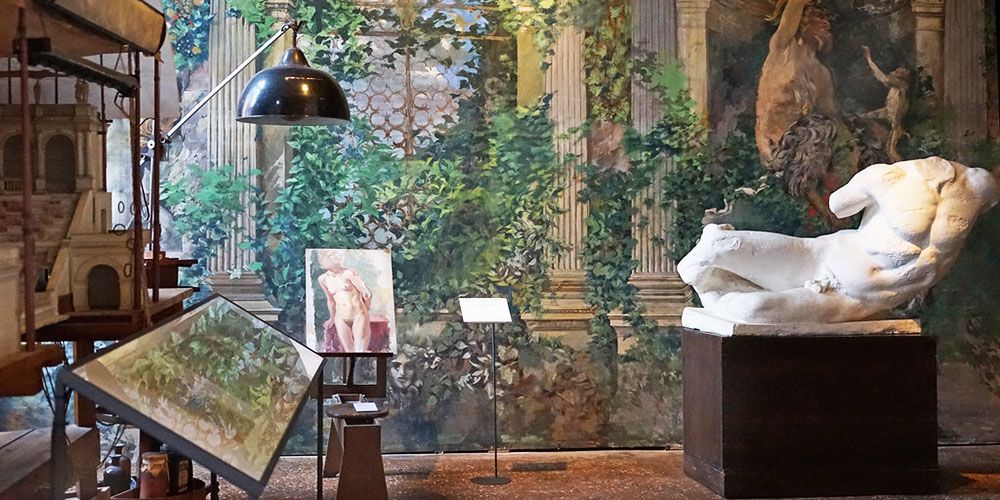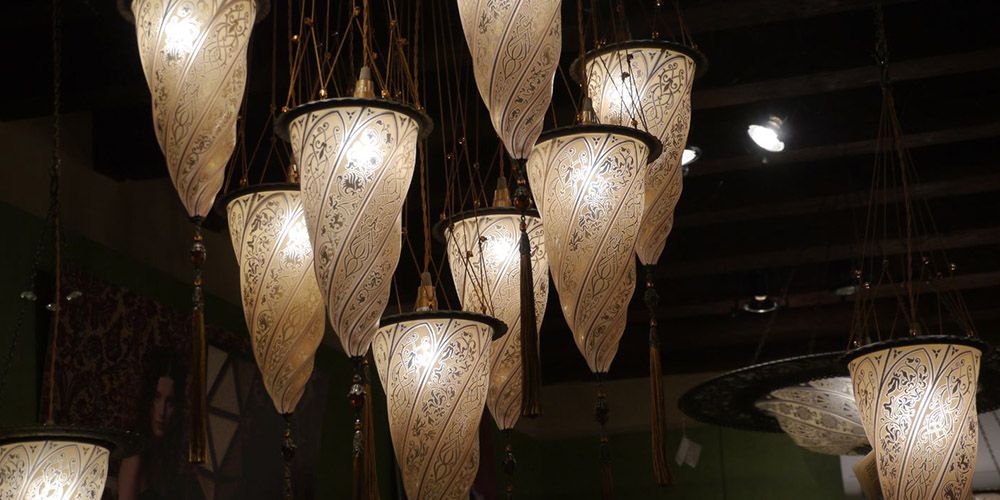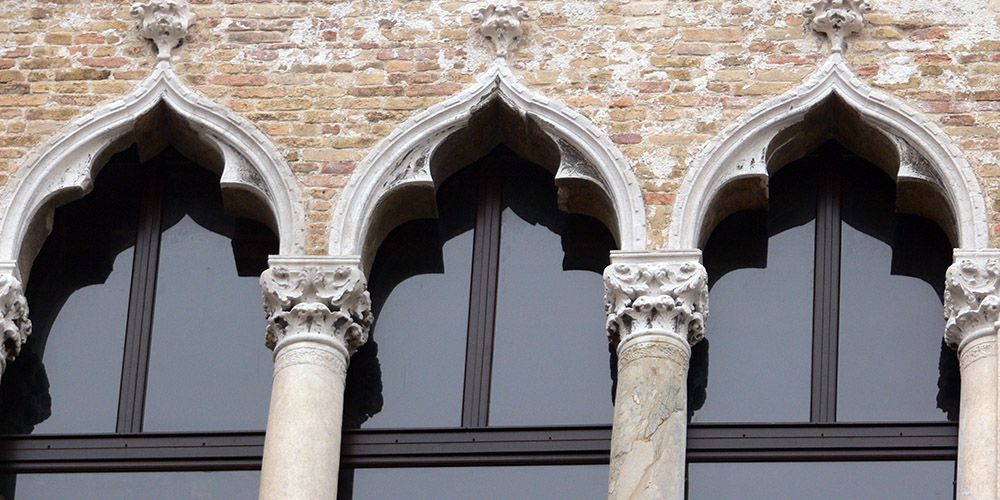Located in the central San Marco district, Museo Fortuny takes its name from its last owner Mariano Fortuny y Madrazo, a set designer, artist, stylist, an eclectic and multifaceted man who bought the building at the end of the 19th century to make it his atelier, since then it was called Palazzo Fortuny. If you are a lover of art, fashion and of that creative energy that with verve sets the imagination in motion, consider a visit to Museo Fortuny as a fundamental stop on your trip to Venice.
Visiting Museo Fortuny means immersing yourself in the creativity of a brilliant artist, encountering his world and sharing the creative processes that gave life to the works and innovations of Mariano Fortuny. Upon his death, his wife Henriette donated the palace to the Municipality of Venice. Today it is part of the circuit of the Civic Museums of Venice and is included in the Venice Pass, a card that in a single ticket will allow you access to the main attractions of the Lagoon, with also unlimited access to water transport, a very useful advantage for visiting Venice without too many worries.
The Fortuny Museum and its history

Located in one of the nerve centers of beautiful Venice, a few minutes’ walk from Piazza San Marco, the Fortuny Museum is housed in a fascinating late Gothic palace, one of the best examples of Venetian Gothic architecture. Mariano Fortuny was struck by the undeniable beauty, at the time decadent, of this building and decided to purchase it to create his artistic atelier. At the beginning of the 20th century, he began gradual but constant restoration work until it was restored to its initial splendor.
The Palace dates back to the 15th century, founded by the Pesaro nobles, who lived there until the 18th century, for a period it also became the seat of the Accademia Filarmonica degli Orfei, from which it took the name Palazzo Pesaro degli Orfei, with which it was called before being renamed Palazzo Fortuny. On the ground floor there is a large internal courtyard, on whose sides two enormous porticoes, 45 meters long, allow light to invade and illuminate the large space. Light was the undeniable attraction of Mariano Fortuny, light that became the fulcrum of his creative act and the guiding thread of his works.
Who was Mariano Fortuny y Madrazo

It is very difficult to enclose Mariano Fortuny in a single definition, Mariano Fortuny devoted himself to painting, photography, engraving, scenography, stagecraft, lighting and applied arts, he also dealt with fashion. With his wife Henriette Negrin he founded the factory for the industrial production of his cotton fabrics and opened boutiques in the major European capitals. A great experimenter, he is responsible for various inventions in the field of theatrical stagecraft and fashion.
Son of an artist, he was born in Granada in 1871, from Spain he moved to Paris and from there at the age of 18 to Venice, here he frequented the major literary and artistic circles of the Lagoon, among his friends: Gabriele D'Annunzio, Ugo Ojetti, Eleonora Duse, Hugo von Hofmannsthal, the Marchesa Casati. In 1900 he created some sets and costumes for the world premiere of Tristan and Isolde at La Scala in Milan. At the same time, he began working on the idea of the “Cupola”, a complex lighting system that revolutionized the stage design of the time and was already being used in major theaters. In 1924 he married Henriette, and it was with her that he created Delphos, a pleated silk tunic dress that made him famous throughout the world; in fact, it is precisely Fortuny who is credited with the idea of pleating and the related patent.
The collections of the Fortuny Museum

The collections present inside the Fortuny Museum include the various artistic fields that Mariano Fortuny dealt with; particular attention is given to painting, photography, light, textiles and the great clothes. The pictorial collection includes 150 paintings by Mariano Fortuny, belonging to various periods of the artist's life starting from the study of a female nude made when he was only 17 years old. It is interesting to discover in the paintings the artist's interdisciplinary research that encompasses his multifaceted spirit, such as the intertwining of painting and photography and painting, theatre and music; these ideas well capture Fortuny's artistic soul. Within the exhibition, a large space is given to light, the dominant motif of Fortuny's research. Chandeliers and lamps in printed and painted fabric and Fortuny diffuser lamps are exhibited.
The photographic collection covers a period from 1850 to the Second World War and Fortuny's production is accompanied by a rich group of images from the collection of the Venetian Civic Museums. Finally, Fortuny's extraordinary textile and fashion production is exhibited, including the artist's greatest success: the Delphos, created in 1909, this is a simple monochrome tunic, inspired by the clothes of the ancient Greeks, the main feature of the Delphos dress was the very fine pleating. Each dress could reach up to 450 pleats. The Delphos was worn by famous ladies of the aristocracy and international nobility, as well as by divine dancers and actresses, who sanctioned its worldwide success.
Mariano Fortuny's ateliers

The true treasures of Fortuny's art are contained on the second floor of the building, dedicated to the library and the ateliers that the artist used to create his works. The beating heart from which Mariano Fortuny's bibliophile soul emanated is the library, a stunning room illuminated by giant Gothic-style windows full of texts, objects, curiosities, tools and above all rare books, precious magazines, volumes of history, art, applied arts, science and technology. All meticulously arranged and ordered by the Fortuny couple, it is here that they took refuge in moments of study and research, we imagine them in this environment as passionate and curious readers.
In the attic of Palazzo Fortuny we find the various ateliers, starting with the one dedicated to engraving, an art that he shared with his father, the atelier dedicated to theater and lighting technology; the photographic atelier, various equipment present here for his experiments on shooting, developing and printing photographs; photography was a source of inspiration, a functional technique for the creation of creations in other fields, such as painting, theatre and fabrics. Continuing in Fortuny's rich research we also find the laboratory dedicated to fashion and fabrics which in a short time became a factory in which a hundred workers were employed, from which boutiques were then born in various European capitals. Visiting these environments will give you the opportunity to discover the figure of the research and experimentation of Mariano Fortuny and its deep connection with Venice.
Temporary exhibitions: Le sincronie by Sergio Monari

The ground floor of the Fortuny Museum also offers temporary exhibitions. At this moment and until May 5, 2025, on display Le sincronie by Sergio Monari. These are sculptures that present themselves as critical reinterpretations of contemporary society, starting from the models and the classical aesthetic conception.
Monari's sculptures can evoke a strong message with great narrative force, which leads us to the urgency of recovering the spiritual dimension within our materialistic era. Sergio Monari, born in 1950, is known above all for his work in sculpture and for his extraordinary ability to actualize universal themes.










Lascia un commento